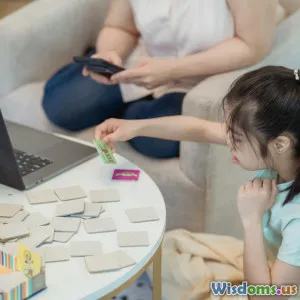
How Gamification is Revolutionizing K12 Classrooms in 2024
8 min read Discover how gamification is transforming K12 education in 2024 by boosting engagement, motivation, and learning outcomes. (0 Reviews)
How Gamification is Revolutionizing K12 Classrooms in 2024
Education is undergoing a dynamic transformation, and at the forefront of this shift is gamification — a powerful tool that is making learning in K12 classrooms more engaging and effective than ever before. In 2024, educators worldwide are harnessing the power of game elements to spark curiosity, improve motivation, and foster a deeper understanding of academic subjects. But what exactly does gamification look like in today’s classrooms? And why is it heralded as a revolution in education? Let’s dive into how this innovative approach is reshaping K12 education.
Introduction: The New Age of Learning Through Play
Gamification is far more than turning lessons into games; it integrates game mechanics such as point scoring, leaderboards, challenges, and rewards to educational content. The objective is simple yet profound: create an immersive environment that captures students’ attention and encourages perseverance. In a world where digital distractions are rampant, this method makes learning irresistible to young minds.
Studies reveal that students in gamified classes can improve engagement rates by up to 60%, while teachers report a notable increase in attendance and participation. This blend of fun and learning gets to the heart of education's biggest challenge – keeping students motivated.
Gamification Mechanics Changing the Classroom Landscape
Incorporating Reward Systems for Positive Reinforcement
One of the core gamification features is the reward system. Badges, stars, and points provide tangible recognition for accomplishments. For example, a 5th-grade teacher in California reported that when her students earned badges for mastering times tables, their average retention improved by 35%. Rewards tap into students’ intrinsic desire to succeed and provide a clear sense of achievement.
Real-Time Feedback and Progress Tracking
Unlike traditional grading systems, gamified learning offers immediate feedback. Interactive quizzes and challenges highlight areas where students excel or need improvement instantly. Platforms like Kahoot! and Classcraft allow students to see their progress, which helps motivate continuous effort. Real-time feedback also enables personalized learning tracks catered to each student’s pace.
Collaborative and Competitive Elements
Games introduce healthy competition and teamwork, which are often missing in conventional classrooms. Through multiplayer and team-based challenges, students develop social skills, collaboration, and critical thinking. For instance, Minecraft: Education Edition is not just a popular game but an educational platform allowing students to work together on building projects, promoting STEM skills in a highly engaging manner.
Impact on Student Engagement and Learning Outcomes
According to a 2023 report by the Institute of Play, districts that implemented gamification strategies saw a 45% reduction in behavioral issues. This increased focus is partially driven by the active participation model inherent in games, which keeps students mentally engaged and reduces distractions.
Furthermore, cognitive neuroscience suggests that learning through interactive gameplay strengthens neural pathways related to problem solving, memory, and adaptive thinking. This aligns with Jean Piaget’s theory of constructivism, which advocates learning through experience—a foundation gamification naturally supports.
A real-world example comes from Finland, known globally for its education system. Schools there have integrated gamified modules into math and language courses. Finnish teachers report improved test scores and higher student enthusiasm compared to traditional teaching methods.
Technological Innovations Driving Gamification Forward
The rise of Artificial Intelligence (AI) and Augmented Reality (AR) technologies in 2024 are key accelerators for gamification in classrooms.
AI-Driven Adaptive Learning
AI allows for creating adaptive games that personalize difficulty levels and content based on each student’s performance. This ensures that no student feels left behind or bored by material that’s too easy. Companies like DreamBox Learning are pioneering this approach with math-focused games that tailor lessons in real time.
AR and Immersive Learning Experiences
Imagine students exploring an ancient Egyptian pyramid right in their classroom through AR headsets. This kind of visual, hands-on gamified experience is becoming mainstream. It builds context and deeper connections to subject matter, far beyond what textbooks can offer.
Challenges and Considerations in Implementing Gamification
Despite its many benefits, successful gamification requires careful planning:
- Balancing Education and Entertainment: The content must retain educational rigor while still being fun.
- Access to Technology: Ensuring equitable access to devices and stable internet remains a hurdle, especially in underfunded districts.
- Teacher Training: Educators need proper training to effectively deploy gamified lessons without overwhelming traditional curricula.
According to Amanda Johnson, an education technology specialist, "Gamification should enhance learning, not replace foundational teaching methods. It requires thoughtful integration and support."
Conclusion: A Transformative Future for K12 Education
The integration of gamification into K12 classrooms is proving to be one of the most influential shifts in education in 2024. By combining technology with well-designed game mechanics, educators are able to teach complex topics more effectively and keep students engaged like never before.
As schools continue to adopt these trends, we can expect a more interactive, personalized, and enjoyable learning experience—one that prepares students not just academically, but also socially and emotionally for the challenges ahead.
The game is changing, and in 2024, it’s clear that gamification is not just a trend but an educational revolution.
References and Resources
- Institute of Play, 2023 Education Impact Report
- Kahoot! Classroom Success Stories
- DreamBox Learning Case Studies
- Ministry of Education, Finland: Education Innovations Report 2023
- Piaget, J. (1952). The Origins of Intelligence in Children.
Rate the Post
User Reviews
Popular Posts




















